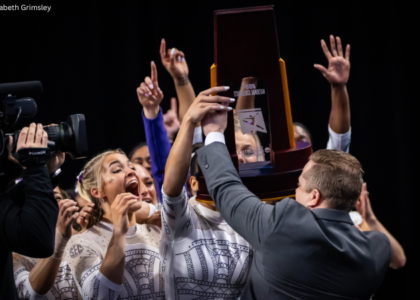Welcome to Data Deep Dive, our new series where we explore the limits of data analysis in college gymnastics. While some sports such as baseball and football rely heavily on data in both team strategy and media coverage, gymnastics data is often hard to come by, difficult to compile and prone to human error. In addition, competitions—particularly in elite gymnastics—are so few in number that any attempts at deep analysis are likely flawed due to the small sample size. In club and college gymnastics, however, the higher number of competitions each year leaves some room for analysis.
This week we’re tackling freshman class rankings: Is it possible to come up with rankings purely from a data standpoint?
Methodology
Using USA Gymnastics level 10 data for all incoming freshmen compiled from MyMeetScores.com, we calculated a “potential index” on each event by averaging the top 25% of scores across their entire club careers. We elected to do this instead of a more traditional average to reward those gymnasts with higher potential rather than higher consistency, since consistency should hopefully improve as a gymnast enters college and is no longer focusing on upgrading her skills. The minimum number of scores required on an event was eight, but if the gymnast did not have that many, we averaged the top two scores instead. For elite gymnasts who did not compete in any level 10 meets in 2019 or 2020, we simply used their highest level 10 score on each event. Once we had those potential indices calculated, we averaged the top two scorers on each event in each school’s freshman class and added them up.
The obvious drawback of this method is the lack of scores for elites and internationals; while most Canadian freshmen have competed in a few USAG level 10 meets and had scores available for this calculation, there were some notable exceptions, and not even all American elites had competed level 10 at some point. The teams most affected by this were UCLA, Georgia, Stanford and LIU.
Results
| Rank | Team | Total |
| 1 | California | 39.1731 |
| 2 | Denver | 39.0871 |
| 3 | Oklahoma | 39.0724 |
| 4 | LSU | 39.0147 |
| 5 | UCLA | 38.9526 |
| 6 | Utah | 38.9517 |
| 7 | Michigan | 38.8878 |
| 8 | Florida | 38.8347 |
| 9 | Washington | 38.7974 |
| 10 | Boise State | 38.7384 |
| 11 | Penn State | 38.6622 |
| 12 | Maryland | 38.6585 |
| 13 | Auburn | 38.6480 |
| 14 | Arizona State | 38.6333 |
| 15 | UC Davis | 38.6295 |
| 16 | Oregon State | 38.6124 |
| 17 | Arizona | 38.6111 |
| 18 | Georgia | 38.5750 |
| 19 | Minnesota | 38.5689 |
| 20 | Michigan State | 38.5565 |
| 21 | N.C. State | 38.5173 |
| 22 | Missouri | 38.5001 |
| 23 | Kentucky | 38.4805 |
| 24 | Northern Illinois | 38.4304 |
| 25 | BYU | 38.4247 |
It should come as no surprise to see California on top of this ranking, with its two top five all arounders in Andrea Li and Gabby Perea highlighting a deep class of six freshmen. Denver also has a solid class full of top all arounders, so the second highest total makes sense. The rest of the top eight are as expected, though Oklahoma perhaps overperforms in this methodology due to its enormous class—nine freshmen!—which allows for less heralded event specialists to shine more than they would in a purely subjective ranking. Another beneficiary of this methodology is Maryland, whose high-scoring freshman Alexa Rothenbuescher hasn’t competed since 2018, so her likelihood of competing in 2021 is uncertain.
It may seem like a surprise to see UC Davis and Northern Illinois make this list, but both have brought in stellar athletes who should help them jump in the rankings. Pay particular attention to Emma Otsu and Kaitlyn Lyle for the Aggies and Alyssa Al-Ashari for the Huskies.
What do you think about this methodology? Do you have any other ideas for using data to rank freshman classes? Let us know in the comments or on social media!
READ THIS NEXT: CGN Roundtable: On Eliminated Programs
Article by Jenna King
Like what you see? Consider donating to support our efforts throughout the year!





4 comments